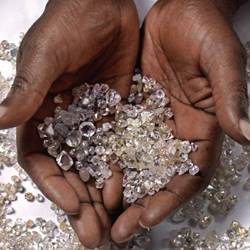|
News
Articles from DIAMONDS BY CUT - BRILLIANT (ROUND) (292 Articles), INDUSTRY ASSOCIATIONS (263 Articles)

The WDC has endorsed a change to the definition of conflict diamonds
Doubts over conflict diamond definition
 2.9 k views | Posted May 21, 2012 2.9 k views | Posted May 21, 2012 | By Dean Millard • Staff Journalist
A recent proposal by the World Diamond Council to change the definition
of conflict diamonds has been described as a good idea, but ultimately
“a waste of time”.
The World Diamond Council recently endorsed the need for the Kimberley Process’s definition of conflict diamonds to evolve at its eighth annual meeting, but some Australian retailers don’t expect it will have any affect on the local retail industry.
Jeweller spoke with a number of retailers this week to gauge their response to the decision to amend the current definition - “diamonds which are illegally traded to fund conflicts.”
The WDC proposal is to change the definition to include “diamond-related violence in rough diamond producing and trading areas”.
One regional jeweller, who asked not to be identified, said she didn’t believe a change to the definition would have an impact on retailers as she didn’t expect the customer base would be aware of it at all.
The jewellery store owner said she could not recall a customer ever inquiring as to whether the diamond they were inspecting was conflict free and she suspected most customers were completely unaware of the concept of conflict diamonds.
Perhaps more importantly, she said while the issue of conflict diamonds was clearly very important, the average jewellery retailer in Australia, particularly those in regional areas, had more pressing concerns to deal with in the running of their business.
A second regional retailer said he had also never had a customer approach him about conflict diamonds, and added that if he did he was not confident he would be able to explain the current definition of what a conflict diamond was anyway.
But it’s not all indifference in the community, with Michael Kearney from Purdey’s Jewellers in Shepparton saying while he was rarely approached about the issue, it was clear to him from discussions with customers it was something they were thinking about.
“What normally triggers the conversation is when we are showing them [customer] white argyle diamonds,” Kearney said. “We are in a very competitive market and that offers a point of difference. I sense that when chaps are looking for diamonds they are looking for something with a point of difference so the fact that it is Australian means they are confident it is conflict free. So they are aware of it, it’s in the back of their minds when they are looking, but they are not asking the question upfront.”
An instrument for change
Lost River Diamonds owner Jim Lehman, who himself has worked as a miner and explorer in a number of African countries that have previously been at the centre of the conflict diamond issue, said the lack of understanding of the political and socio-economic issues surrounding conflict diamonds was currently hampering those countries in their efforts to rebuild.
He said the proposed changes to the definition by the World Diamond Council were a good thing but with the changes needed to be an awareness campaign of the role the diamond industry needed to play in helping some countries get back on their feet.
“What we need to do is let people know that the diamond industry now is doing more good in most African countries,” Lehman said. “I hold talks for local retailers to explain what conflict diamonds are. Being managing director and CEO of a diamond mining exploration in Africa at the time I was very much aware of the danger and damage the whole issue is causing the black African community who are legitimately mining and selling diamonds.”
He said as a diamond supplier he sells Argyle diamonds and often people chose them because of the confidence it gave them that it was conflict free, adding there was an assumption that by comparison any diamonds coming out of Africa were not.
“Customers won’t buy the African diamonds because there could be a conflict, but these people desperately need the money for their diamonds. In Botswana that’s their number one source of income, and it is a beautiful country and a very well run country, but people will say, no we don’t want African diamonds because there could be a conflict, well those conflicts don’t exist, but there is a human rights issue. There is a human rights issue with Saudi Arabia as well, but we still buy their oil, ” Lehman said.
Leading Australian diamond expert Gary Holloway also picked up on the hypocrisy of the way the diamond industry is scrutinised in comparison to other industries such as oil. “Nobody questions where the oil comes from every week when they fill the petrol tank in their car,” Holloway said. “It is a sad thing that the diamond industry is a tall poppy to an extent on this issue.”
Hot air
Holloway said while the new definition was good he felt the debate was a waste of time as he doubted all of the countries involved would back the change.
“I don’t think it will ever get ratified, so it is a complete waste of time,” Holloway said. “It is a good idea, but all of this discussion amounts to hot air, basically, because it will never be ratified by certain countries, and when the existing statute for the Kimberley Process was put in place it required 100 per cent support [for a change].”
Holloway said if the change to the definition was ratified it would allow the industry to put even more pressure on “despots who put pressure on their own people”, however the WDC was limited in what it could achieve through the Kimberley Process and as a consequence he felt sometimes too much was expected of the process.
“The statute that was written in the original Kimberley Process was not set up to be a human rights tool, that is not to say it couldn’t have been, but it wasn’t and so far it has achieved what it was set up to do,” Holloway said.
“I think had it been set up as a human rights tool 10 years ago it probably would not have got up then, either. In order to get ratified it needs to have 100 per cent support, and unfortunately it won’t receive that from a handful of countries.
“It is sad to try and change the Kimberley Process to something that it was never designed to be. It would be simpler and more effective to start again with something new with the United Nations,” Holloway explained.
According to the WDC, less than one per cent of the world’s diamonds are conflict diamonds by the current definition, down from approximately four per cent in the late 1990s.
The Kimberley Process requires each shipment of rough diamonds crossing an international border to be transported in a tamper-resistant container and be accompanied by a government validated Kimberley Process Certificate, which can only be exported to another Kimberley Process participant country.
More reading
The right way to promote ethics
|
|
|
|